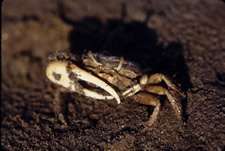Biologist Discovers What May Be World's 'Pickiest' Mates

California fiddler crabs may be among the world’s pickiest animal when it comes to selecting a mate.
A study conducted by a biologist at the University of California, San Diego that appears in the August issue of the journal Animal Behaviour found that females of the species Uca crenulata may check out 100 or more male fiddler crabs and their burrows before finally deciding on a mate.
“As far as I know, no other species has been observed sampling nearly as many candidates as the California fiddler crab,” said Catherine deRivera, who conducted the study while a doctoral student and a lecturer at UCSD. She is now a research biologist at the Aquatic Bioinvasions Research and Policy Institute, a joint entity of the Smithsonian Environmental Research Center and Portland State University.
deRivera and a group of UCSD students who assisted her conducted their observations in the Sweetwater River estuary in Chula Vista, south of San Diego, near the Mexico-U.S. border. She said previous studies of mate selection in other animals, such as birds and the natterjack toad, found that females of most species typically sampled only a handful of potential mates before making a final selection.
“Most animals sample just a few mates, presumably because search costs override the benefits of lengthy searches,” she said in her paper. But female California fiddler crabs are much pickier, she discovered in her study, checking out male suitors and their bachelor pads an average of 23 times before making a final selection. One particularly choosy crab visited 106 male burrows, fully entering 15 of them, during her one hour and six minute search.
Why are female fiddler crabs so picky? The survival of their offspring, deRivera found in her experiments, appears to be strongly linked to the size of their mate and, more importantly, his corresponding abode.
“The size of the male’s burrow affects the development time of his larvae,” she said. “A burrow of just the right size allows larvae to hatch at the safest time, the peak outward nighttime flow of the biweekly tidal cycle.”
“Wide burrows speed incubation, so they cause the larvae to hatch too early and miss the peak tides. This research provides one of the first examples of how choosy resource selection can help offspring survivorship.”
Male fiddler crabs attract suitors by standing in front of their burrows and waving their enlarged claws at prospective female passers by, much as humans motions “come here” with their arms and hands
“The California fiddler crabs use a lateral wave that looks much like a human beckoning 'come here’,” deRivera said. “It also seems to serve as a 'come hither' signal, as a male waves, standing at his burrow entrance, and interested females come over.”
Interested females initially eye the males, who select their burrows based upon their body size, and if they’re interested, partially or fully enter a burrow to size it up.
“The burrow openings, which are circular, are just big enough for the owners to get in,” deRivera said. “Crabs enter burrows sideways so have to fit in front to back and top to bottom.”
When a female has found a mate and burrow to her liking, typically one that is about the same size as she, either she or the male will plug up the opening of the burrow and the couple will mate and incubate their eggs, which later hatch and release tiny crab larvae that are quickly flushed from the estuary by high night tides.
deRivera found that larger female crabs couldn’t be as picky about choosing mates as their smaller counterparts. They took less time, she noted, because they entered fewer burrows, primarily because many of the burrows they passed were too small to accommodate them and successfully incubate their eggs and release their larvae.
“Larvae were successfully released during high-amplitude nocturnal tides only when females incubated in burrows that allowed the larvae to exit the estuary swiftly and thus reduce predation risk, but not when females incubated in burrows that were too wide or narrow,” deRivera writes in her paper. “The effect of burrow aperture on incubation duration may explain why females sampled many male burrows as they searched for a mate and why females of different size classes selected and sampled differently.”
Source: UCSD


















